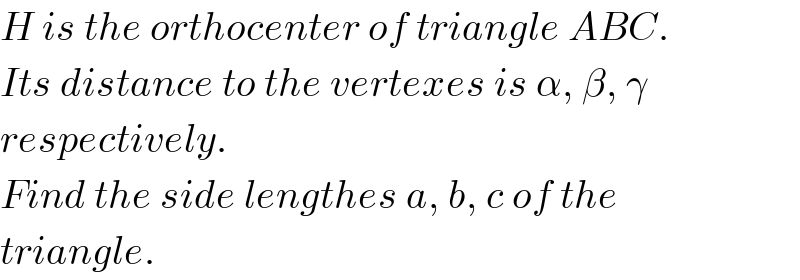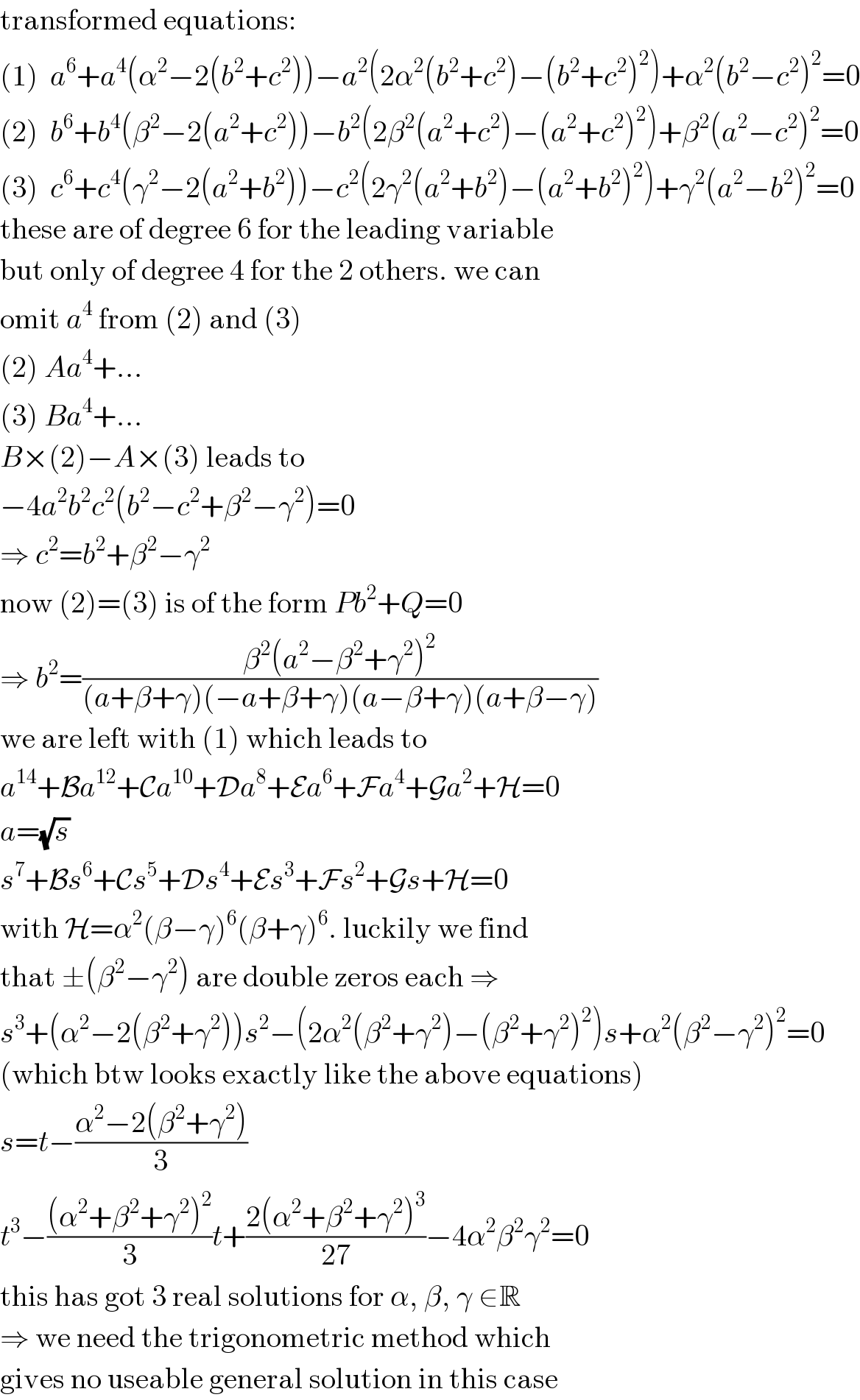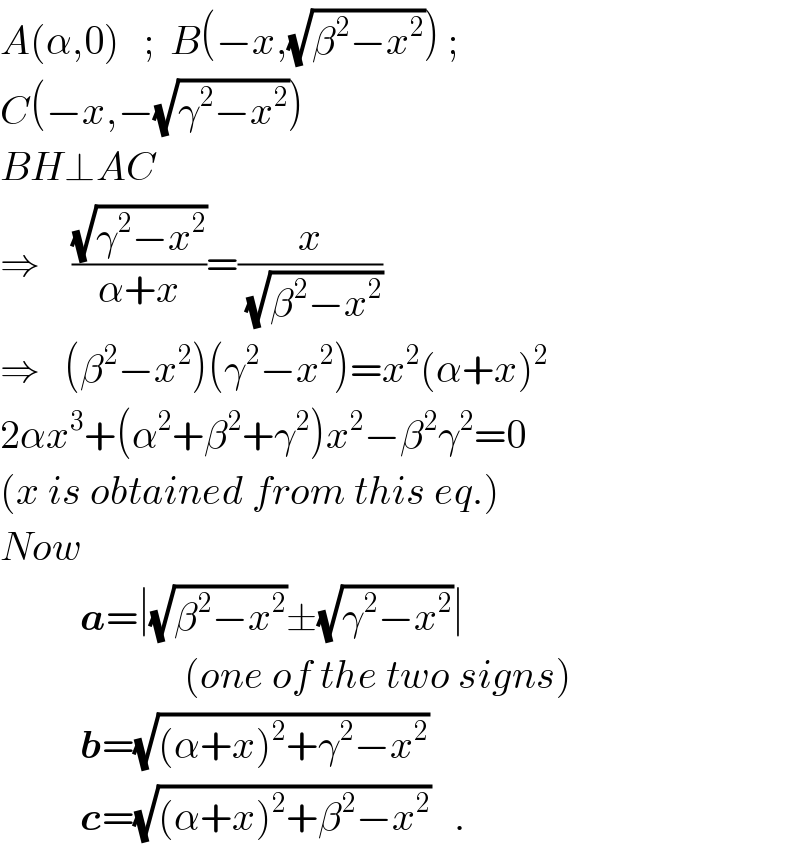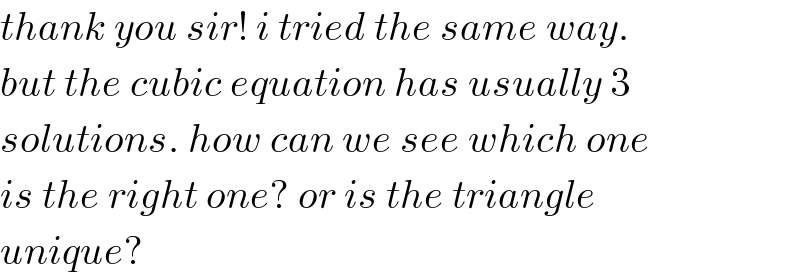
Question and Answers Forum
Question Number 61861 by mr W last updated on 10/Jun/19

Commented by mr W last updated on 10/Jun/19

Commented by MJS last updated on 11/Jun/19

Commented by MJS last updated on 11/Jun/19
![the distances are (1) α=((a(−a^2 +b^2 +c^2 ))/δ) (2) β=((b(a^2 −b^2 +c^2 ))/δ) (3) γ=((c(a^2 +b^2 −c^2 ))/δ) [with δ=(√((a+b+c)(−a+b+c)(a−b+c)(a+b−c)))] we can solve this for given α, β, γ for α=5, β=6, γ=7 I get ((a),(b),(c) ) = (((5.142053)),((3.929466)),((1.562276)) ) ∨ ((a),(b),(c) ) = (((10.94952)),((10.43514)),((9.792451)) ) the 3^(rd) solution is not valid because a, b, c ∉R](Q61910.png)
Commented by mr W last updated on 12/Jun/19

Commented by MJS last updated on 12/Jun/19

Answered by ajfour last updated on 10/Jun/19

Commented by ajfour last updated on 10/Jun/19

Commented by mr W last updated on 10/Jun/19

Answered by mr W last updated on 12/Jun/19

Commented by mr W last updated on 21/Jun/19
![assume α≥β≥γ. let HD=u=λα BD=(√(β^2 −u^2 )) DC=(√(γ^2 −u^2 )) ((DC)/(HD))=((AD)/(BD)) ((√(γ^2 −u^2 ))/u)=((u+α)/(√(β^2 −u^2 ))) ⇒(√((β^2 −u^2 )(γ^2 −u^2 )))=u(u+α) ⇒(β^2 −u^2 )(γ^2 −u^2 )=u^2 (u^2 +2αu+α^2 ) ⇒2αu^3 +(α^2 +β^2 +γ^2 )u^2 −β^2 γ^2 =0 ⇒λ^3 +((α^2 +β^2 +γ^2 )/(2α^2 ))λ^2 −((β^2 γ^2 )/(2α^4 ))=0 with q=((α^2 +β^2 +γ^2 )/(6α^2 )), r=((β^2 γ^2 )/(4α^4 )) let p=(r/q^3 )=((54α^2 β^2 γ^2 )/((α^2 +β^2 +γ^2 )^3 ))≤2 ⇒λ^3 +3qλ^2 −2r=0 with λ=s−q ⇒s^3 −3q^2 s+2(q^3 −r)=0 Δ=(−q^2 )^3 +(q^3 −r)^2 =−(2−(r/q^3 ))rq^3 <0 ⇒s=2q sin {(1/3)[sin^(−1) (1−p)+2kπ]}, k=0,1,2 ⇒λ=s−q=q{2 sin [(1/3) sin^(−1) (1−p)+(2/3)kπ]−1}, k=0,1,2 two solutions are suitable: k=0 and 1 ⇒λ=q[2 sin {(1/3) sin^(−1) (1−p)}−1]<0 or ⇒λ=q[2 sin {(1/3) sin^(−1) (1−p)+((2π)/3)}−1]>0 ⇒a=(√(β^2 −λ^2 α^2 ))±(√(γ^2 −λ^2 α^2 )) (−ve for λ<0) ⇒b=(√((1+2λ)α^2 +γ^2 )) ⇒c=(√((1+2λ)α^2 +β^2 )) example: α=7, β=6, γ=5 ⇒λ=0.35604 / −0.597544 ⇒a=9.792451 / 1.562276 ⇒b=10.435137 / 3.929466 ⇒c=10.949525 / 5.142053](Q61956.png)
Commented by MJS last updated on 12/Jun/19

Answered by ajfour last updated on 12/Jun/19

Commented by mr W last updated on 13/Jun/19

Commented by ajfour last updated on 13/Jun/19
![let B origin. H(βcos θ,βsin θ) ....(i) A(βcos θ,βsin θ±α) ...(ii) eq. of AB: y=xcot φ eq. of AC: y=−(x−a)cot θ y_A =x_A cot φ=(a−x_A )cot θ ⇒ x_A =((acot θ)/(cot θ+cot φ))=βcos θ [see (i)] and y_A =x_A cot φ = βsin θ±α [see (ii)] Also βsin θ=γsin φ ⇒ βcos θcot φ=βsin θ±α (βcos θ)(((±(√(1−((β^2 sin^2 θ)/γ^2 ))))/((βsin θ)/γ)))=βsin θ±α let sin^2 θ=t ⇒ (1−t)(γ^2 −β^2 t)=t(β^2 t+α^2 ±2αβ(√t)) ⇒ γ^2 −β^2 t−γ^2 t+β^2 t^2 =β^2 t^2 +α^2 t±2αβt(√t) ⇒ 4α^2 β^2 t^3 =[γ^2 −(α^2 +β^2 +γ^2 )t]^2 or 4α^2 β^2 t^3 −(α^2 +β^2 +γ^2 )^2 t^2 +2γ^2 (α^2 +β^2 +γ^2 )^2 t−γ^4 =0 for α=7, β=6, γ=5 ....](Q61977.png)
Commented by ajfour last updated on 13/Jun/19

Commented by ajfour last updated on 13/Jun/19

